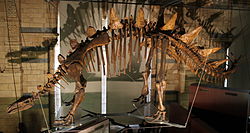Tuojiangosaurus
|
Tuojiangosaurus Temporal range: Late Jurassic, 160 Ma |
|
|---|---|
 |
|
| Mounted skeleton at the Natural History Museum, London | |
| Scientific classification | |
| Kingdom: | Animalia |
| Phylum: | Chordata |
| Class: | Reptilia |
| Clade: | Dinosauria |
| Order: | †Ornithischia |
| Suborder: | †Stegosauria |
| Family: | †Stegosauridae |
| Genus: |
†Tuojiangosaurus Dong et al., 1977 |
| Species: | †T. multispinus |
| Binomial name | |
|
Tuojiangosaurus multispinus Dong et al., 1977 |
|
Tuojiangosaurus (meaning "Tuo River lizard") is a genus of herbivorous stegosaurid dinosaur from the Late Jurassic Period, recovered from the Upper Shaximiao Formation of what is now Sichuan Province in China.
Physically similar to the North American Stegosaurus, Tuojiangosaurus is the best understood of the Chinese stegosaurids. It was around 7 metres (23 ft) long and 2 metres (6.6 ft) high. In 2010, Gregory S. Paul estimated the weight of a 6.5 metres long Tuojiangosaurus at 2.8 tonnes.
In 1977, Dong provided a diagnosis but this largely consisted of traits shared with other stegosaurs. In 1990, Peter Malcolm Galton pointed out an autapomorphy: the spines of the vertebrae of the tail base possess spines with bony skirts running from their front to the sides.
Tuojiangosaurus has the typical narrow and low head, bulky body, and low teeth of other stegosaurids. The limbs, especially the arms, are rather short. There are at least twenty-five dentary teeth. The teeth have a thick base, cingulum, merging at the inside into a triangular vertical median ridge. The dorsal vertebrae have tall neural arches. The shoulderblade has a rectangular acromion.
Like Kentrosaurus, Tuojiangosaurus had two rows of plates along the spine, which became taller over the hip region. Those at the neck and front trunk were rounded or pear-shaped; the plates at the rear back became more triangular and pointed. All plates have a thickened central section, as if they were modified spikes. Dong estimated there were about seventeen pairs of plates and spikes. Tuojiangosaurus had at least two outward-pointing, rather robust, spikes on each side of the end of the tail, angled at approximately 45 degrees to the vertical. In stegosaurids, this spike arrangement has become affectionately known as the "thagomizer". Dong thought it were possible that there were four pairs of spikes. Paul, based on "Chungkingosaurus sp. 3" specimen CV 00208, interpreted the thagomizer as a "pin-cushion array", with two vertical pairs of thick spikes and a third pair of narrow spikes pointing to behind.
...
Wikipedia
